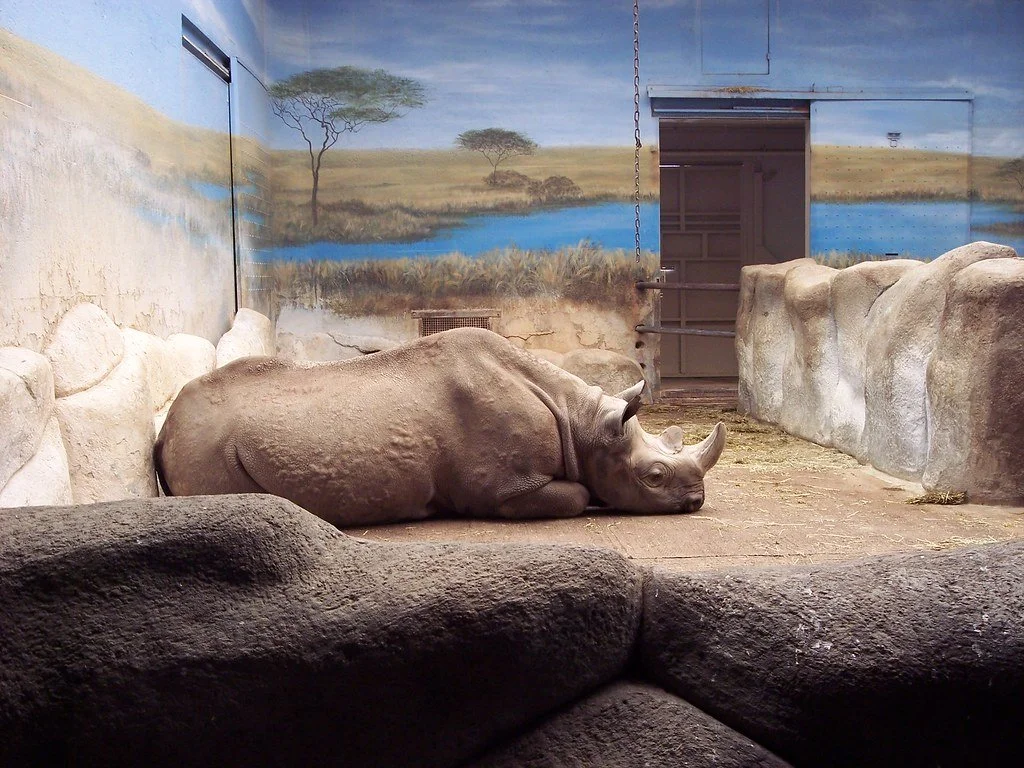Whether they’re born into captivity or captured from the wild, here are the controversial conditions faced by zoo animals today.
Two caged lions at the Los Angeles Zoo. California Historical Society. PDM 1.0
As kids, we visit zoos and aquariums with fascination, associating them with wonder and mystique, unaware of the industry’s negative effects. As we grow up, however, we’re forced to consider whether profiting off of captive animals is moral, and are confronted with zookeepers’ lack of regard for animals' physical and emotional well-being. Today, there are roughly 800,000 animals in the care of AZA-accredited zoos and aquariums worldwide. According to National Geographic, hundreds of zoos have been accused of mistreatment, leading to decreased self-esteem and self-destructive behaviors among animals.
Shamu at SeaWorld show in San Diego. Yathin sk. CC BY-SA 3.0
The ethical debate surrounding zoos primarily revolves around the living conditions in which animals are raised and cared for. In captivity, animals typically have shorter lifespans compared to their counterparts in the wild. Over the last fifty years, the wildlife population worldwide has dwindled by 68%, and 15,000 species are currently listed as endangered. With over 10,000 zoos globally, a significant number fall short of adequate animal care standards. Confined to manmade enclosures, animals often lack space for proper exercise, leading to stress-related issues such as aggression towards caretakers or fellow animals. In aquariums, animals are often exposed to intense UV rays in manmade tanks. At SeaWorld, workers have been accused of hiding animal sunburns and blisters with zinc oxide. SeaWorld has also been accused of starving dolphins, orcas and otters so that they would be more likely to perform tricks for an audience in exchange for treats. Dolphins were even used as surfboards during performances until 2020, when a months-long PETA campaign ultimately stopped trainers from riding on the backs and faces of dolphins.
Rhinoceros at Brookfield Zoo. Lyle. CC BY-NC 2.0
Currently, there are not enough laws protecting the care and maintenance of captive animals. The Animal Welfare Act (AWA) is the only federal law that protects the welfare of zoo animals. Under the AWA, regulations regarding the care and transportation of captive animals are strictly enforced. Cold-blooded animals, however, are excluded from the AWA. In captive environments, animals are frequently bred unnaturally, with artificial insemination being a common practice justified for conservation. Instead of choosing their mates, female animals are artificially inseminated to strengthen populations. Artificial insemination often results in miscarriages, fatal births or mothers rejecting their offspring.
At the end of the day, regardless of how zoos market themselves as nonprofits or driven by education, they operate as businesses that profit from the entertainment provided by captive animals. Admission for a single day at zoos typically ranges from $20 to $60, while SeaWorld charges around $100. SeaWorld claims to have contributed more than $17 million to conservation efforts, but this amounts to just 3.2% of their annual profits. Zoos claim that certain species would be extinct if not for their preservation efforts, but conservation should really be centered around preserving animals' natural habitats, which are threatened by human interference like pollution, deforestation and water contamination. While modern zoos have evolved from the small cages and circus-like performances that characterized the industry's early days, we’re forced to question the ethical grounds for supporting zoos and reconsider whether they truly prioritize conservation over exploitation.
Get Involved
Born Free aims to keep animals in their natural habitat. Check out forty ways to help wild animals here, from shopping more sustainably to volunteering with local conservation projects.
The Humane Society of the United States aims to end animal cruelty practices. Learn about their biggest fights here.
Anyone interested in the controversies surrounding SeaWorld should watch the documentary "Blackfish" to see what happens when killer whales are confined to manmade enclosures.
Agnes Volland
Agnes is a student at UC Berkeley majoring in Interdisciplinary Studies and minoring in Creative Writing, with a research focus on road trip culture in America. She currently writes for BARE Magazine and Caravan Travel & Style Magazine. She is working on a novel that follows two sisters as they road trip down Highway 40, from California to Oklahoma. In the future, she hopes to pursue a career in journalism, publishing, or research.




